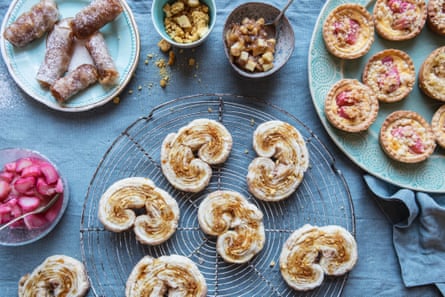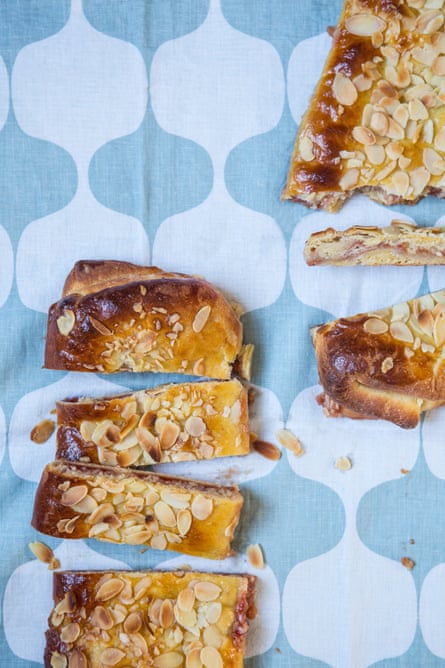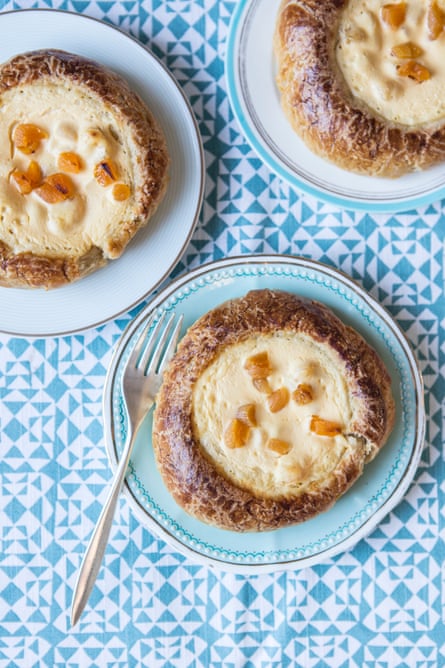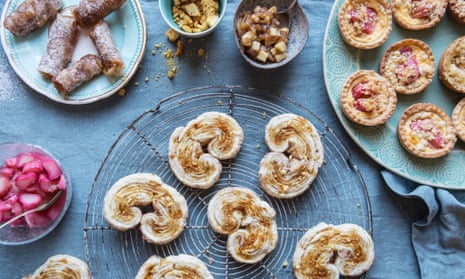Apple and cinnamon spring rolls
Baking’s BFFs apple and cinnamon never disappoint – and especially not in this unusual sweet take on the spring roll. You can use filo pastry, cut to size, in place of the spring roll wrappers.
Serves 4
2 large bramley apples, peeled and cored
50g brown sugar
1 tsp ground cinnamon
½ tsp cornflour
16 spring roll wrappers
1 egg yolk, beaten
750ml sunflower oil
½ tsp cinnamon
½ tsp icing sugar
1 Cut 1 ½ of the apples into wedges and put them in a small saucepan with the brown sugar and cinnamon. Cook over a low heat until soft and mushy. Mix in the cornflour and cook for 1 minute more, or until thickened. Set aside until cool enough to handle. Chop the remaining ½ apple into small chunks and then fold this into the cooked cooked apple mixture.
2 Put two sheets of spring roll wrappers (or filo pastry, if using) on top of each other and lay them in front of you like a diamond.
3 Spoon some apple into the middle of the pastry, fold the sides in and dot with beaten yolk, then do the same with the top corner. Fold the bottom point in and tightly roll at the same time. Repeat with the rest of the mix.
4 Heat the oil in a pan until a piece of bread dropped in browns quickly. Carefully lower the spring rolls (in batches) into the hot oil. Turn once, and when golden remove with a slotted spoon and drain on kitchen paper.
5 Combine the icing sugar and cinnamon. While the spring rolls are still warm, sift over a little of the sugar mix and serve.
Andrew Dargue, Vanilla Black
Cinnamon and honey palmiers
This recipe calls for homemade honeycomb powder – if you’re short on time, simply drizzle honey on your palmiers and allow it to lightly caramelise.
Makes 40
700g ready-made puff pastry
Icing sugar, sieved, for rolling out
1 tsp cinnamon
25g icing sugar
For the honeycomb
82.5g sugar
30g glucose
35g lavender honey
20g water
10g bicarbonate soda
1 First, make the honeycomb. Add the sugar, glucose, honey and water to a thick-bottomed, high-sided pan over a high heat and cook for about 10 minutes, or until a very light caramel colour. If you have a sugar thermometer, when it reaches 150-155C/300-310F it’s ready. Working very quickly, take the pan off the heat and sift in the bicarbonate. Whisk the mixture a few times – be careful as it will be extremely hot – then pour out on to a nonstick mat and set aside to cool. The honeycomb will keep expanding as you pour, so make sure there is sufficient room on the mat.
2 Once completely cool, put a small amount in a freezer bag, and break it up with a rolling pin into a rough powder. Set aside. Store the rest in an airtight container.
3 Preheat the oven to 200C/400F/gas mark 6. Roll the pastry out, using icing sugar in place of flour, until you have a 15cm x 40cm rectangle. Fold the short sides in so they meet in the middle of the rectangle, then repeat, folding in the short sides to meet in the middle. Now fold the two sides up so they join together, then flatten the pastry roll slightly. Cut this into 1cm-wide slices. Lay these, evenly spaced, face down on a baking tray lined with parchment, so the pattern of the folds is showing upwards, not sideways. Bake for 8 minutes.
4 Remove the palmiers from the oven and sprinkle with powdered honeycomb (or honey, if using), taking care not to get any on the baking tray, then return to the oven for 4 minutes, or until light golden brown.
5 Take them out of the oven. Combine the cinnamon and icing sugar, then sprinkle over the top of the palmiers through a sieve. Allow to cool before serving.
Michael Wignall, The Latymer, pennyhillpark.co.uk

Rhubarb and custard tartlets
A recipe for organised bakers – the pastry, cream and crumble should ideally be made the night before you assemble these tartlets. Furthermore, the quantities here make double the amount of pastry you will need, giving you three days to dream up another sweet batch of pastries.
Makes 12
220g butter, at room temperature
380g plain flour
140g icing sugar
55g ground almonds
1 egg
1 egg yolk
½ tsp fine sea salt
For the pastry cream
½ vanilla pod, split, seeds scraped and reserved
250ml milk
50g caster sugar
3 egg yolks
20g cornflour
For the crumble topping
150g plain flour
100g salted butter, chilled and diced
50g caster sugar
For the filling
200g rhubarb, chopped into 2cm lengths
40g sugar
2 tbsp lemon juice
1 To make the pastry, beat the butter until light and creamy. Add 100g of the flour, the icing sugar, the ground almonds, the egg and egg yolk and the salt. Mix until a soft paste forms, then add the rest of the flour and mix until just combined. Divide the dough into two equal parts, wrap in clingfilm, pressing to create a disc, then chill for at least 2 hours, ideally overnight.
2 Next make the pastry cream. Put the vanilla pod and seeds in a small saucepan with the milk and the sugar. Heat the milk mixture until just boiling, stirring regularly.
3 Meanwhile, whisk the egg yolks and cornflour until pale in colour.
4 Gently and slowly pour the hot milk mixture on to the yolks, whisking constantly, then strain it all through a sieve, back into the saucepan. Return the vanilla pod to the pan. Over a low heat, stir the mix until it thickens into a custard. Once it starts to bubble, cook for 2-3 more minutes, stirring all the time.
5 Pour the custard into a clean bowl and cover with clingfilm touching the surface to prevent a skin from forming. Chill for at least 1 hour, ideally overnight.
6 For the crumble, in a bowl rub the butter into the flour until the mixture resembles breadcrumbs. Add the sugar and continue until you’re left with large nuggets of buttery dough. Spread this out on a baking tray lined with parchment paper and chill in the fridge uncovered for at least 1 hour, ideally overnight.
7 To make the filling, put the rhubarb in a saucepan with the sugar and the lemon juice. Heat slowly until soft, then stir occasionally until you have a light, chunky compote. Set aside to cool, then cover and chill.
8 Remove one portion of pastry dough from the fridge. On a lightly floured worktop, roll it out to a thickness of 3mm. Using a 9cm round cutter, dipped lightly in flour, cut out 12 rounds of dough and put them into 5cm tartlet tins. Press the pastry down well around the base and sides of the tin. Put into the freezer for about 30 minutes, while you preheat the oven to 180C/350F/gas mark 4.
9 Fill the chilled tartlets with the chilled pastry cream, then a few chunks of rhubarb and a good topping of crumble. Bake for 20‑25 minutes, until the pastry is cooked through and the crumble is golden.
Roy Levy and Gail Mejia, Gail’s Artisan Bakery Cookbook (Ebury)
Lengua de suegra
This Peruvian pastry showcases manjar blanco – a toothsome, milky filling not dissimilar to dulce de leche. For ease and expediency, this adaptation uses ready-made puff pastry.
Serves 4
500g ready-made puff pastry
1 egg, beaten, for glazing
1 tsp icing sugar, for dusting
For the filling
200ml evaporated milk or single cream
200ml condensed milk
1 cinnamon stick
3 cloves
Seeds of 1 vanilla pod
1 First, make the filling. Combine the evaporated milk (or single cream, if using) and the condensed milk in a saucepan. Add the cinnamon, cloves and vanilla seeds and bring to a rolling boil. Turn down the heat to low and cook until thickened, stirring constantly. When it’s a light caramel colour, remove from the heat, strain through a sieve and set aside to cool before chilling in the fridge.
2 Preheat the oven to 180C/350F/gas mark 4. Roll the pastry out to a thickness of 5mm. Cut into eight 15cm x 3cm rectangles. Put on a greased baking tray and brush with the beaten egg. Bake for 15 minutes.
3 Once golden brown and puffed up, take out of the oven and slice each sideways carefully through the middle creating a base and a top. Cover each base with a thick layer of filling then pop the top back on. Dust with icing sugar and serve.
Adapted from a recipe by Martin Morales and Veronica Avila, Andina
Hazelnut pithiviers
This nutty patisserie is delicious served with a salted caramel sauce.
Makes 6
600g ready-made puff pastry
1 egg, whisked with a pinch of salt, for glazing
For the filling
115g whole hazelnuts
100g caster sugar
85g unsalted butter, softened
1 tbsp dark rum
1 tsp vanilla extract
A large pinch of cinnamon
3 egg yolks
45g plain flour
1 Make the filling first. Pulse the hazelnuts and sugar in a food processor until finely ground. Add the butter, rum, vanilla, cinnamon and egg yolks, then pulse again to combine. Add the flour, pulse again, then transfer into a bowl. Cover loosely and set aside.
2 Next, on a floured surface, roll out the pastry to form a 20cm x 30cm rectangle. Cut in half. Roll one half to 20cm x 30cm and the other half to 24cm x 36cm.
3 Cut the smaller sheet of pastry into 10cm squares. Put on a baking tray lined with parchment and divide the filling equally among them, making a 5cm-diameter mound in the centre of each.
4 Cut the remaining piece of pastry into 12cm squares. Carefully brush egg wash around the edge of each filling and put a square of pastry on top. Cup your hand over the centre and press the pastry around the filling, leaving no air pockets, then line up the sides of the pastry.
5 Put a 5cm-diameter round biscuit cutter over the filling and press lightly to seal the layers of dough together, but make sure you don’t actually cut the pastry. Use a 10cm round cutter to cut out each of the sealed pastry parcels.
6 Indent the edges of the pastries using the back of a paring knife. Make several arc-shaped slashes in the top of each pastry, only cutting about halfway through the pastry. Cover and chill for at least 4 hours or overnight, if possible.
7 Preheat the oven to 200C/400F/gas mark 6. Brush the pastries with egg wash and bake for 45–55 minutes until well-risen and deeply golden. Serve warm.
Adapted from Nick Malgieri, Pastry Perfection (Kyle Books)
Kringle with rosehip jam
This Nordic farmhouse special combines a rich, buttery dough with a jam and almond filling. Perfect for breakfasts and wintertime teas, it is best eaten the day it’s made.

Makes 3
100ml lukewarm whole milk
50g fresh yeast
3 eggs, lightly beaten
100g caster sugar
½ tsp salt
350g butter
550g 00-grade (tipo 00) plain flour, plus extra for dusting
For the filling
150g almonds, chopped
200g caster sugar
250g butter
300g rosehip jam (or other jam or compote)
1 egg, lightly beaten
50g flaked almonds
1 Pour the milk into a bowl, crumble over the yeast and stir to dissolve. Mix in the eggs, sugar and salt, cover and leave for 30 minutes. Meanwhile, cut the butter into cubes and rub into the flour. When ready, mix the yeast mixture into the flour mixture. Knead on a floured work surface until you have a smooth dough. The dough is very delicate, so you might have to use a bit more flour and handle it with care. Put the dough in a bowl, cover and leave to rise at warm room temperature for about 1 hour.
2 For the filling, mix the chopped almonds into a paste with the caster sugar and butter, then set aside.
3 On a floured work surface, roll the dough out into a rectangle. Fold it into thirds on the longest edge, like a business letter, then turn it 90 degrees, roll it out and fold it once more, in the same way. Divide the dough into three portions and roll each out into a rectangle.
4 Divide the filling into thirds. Spread each portion over a 4cm-wide strip down the middle of each dough rectangle. Spread the rosehip jam on top. Fold the short ends up over the filling and then the long sides like a parcel, so the edges overlap by 1cm. Put on baking trays lined with baking parchment, cover with tea towels and set aside to rise in a warm place for 30 minutes.
5 Preheat the oven to 210C/425F/gas mark 7. Brush each pastry with the egg and sprinkle with the flaked almonds. Bake for 15-20 minutes, keeping an eye on them so they don’t turn too dark. Cool on a wire rack and serve warm or cold.
Trine Hahnemann, Scandinavian Baking (Quadrille)
Persimmon turnovers
The persimmon (also known as the sharon fruit or kaki) is a great baking companion. These simple turnovers call for the gooey sweetness of particularly ripe specimens.
Makes 10
250g spelt or plain flour, plus more for dusting
190g cold butter, cut into 1cm cubes
125ml cold water
For the filling
1kg over-ripe persimmons, halved, the insides scraped out and mashed
10 tbsp honey or maple syrup
1 Put the mashed persimmons in a saucepan with the honey, or maple syrup, if using. Bring to the boil and simmer for 10 minutes. Set aside to cool, then chill.
2 Put the flour in a bowl, add the butter and stir, then mix in the water until it comes together as a dough. Roll it out into a large rectangle on a lightly floured surface. Fold over one short side of the dough by one-third of the rectangle’s length, then fold the other short side over the top. Give the folded pastry a quarter turn. Roll out the sheet again, then repeat the folding. Put in a clean plastic bag and chill for 30 minutes.
3 Preheat the oven to 180C/350F/gas mark 4. On a floured surface, roll out the pastry to 4-5mm thick and cut into 10cm squares. Put 1 tbsp of the persimmon mixture in the centre of each, brush the edges with a little water and fold over diagonally into a triangle. Seal the edges with a fork and pierce the top. Bake for 25–30 minutes until risen and golden.
Tom Hunt, The Natural Cook (Quadrille)
Vatrushki with apricots
These creamy Eastern European pastries are sweet and adaptable – raisins can be used in place of apricots, and orange zest or saffron are good substitutes for the vanilla.

Makes 4
7g dried yeast
30g caster sugar
1 egg yolk
A large pinch of salt
125ml warm milk
125g butter, melted
350g plain flour plus extra for dusting
1 egg, beaten, for glazing
For the filling
250g Polish twarog or curd cheese
1 egg yolk
1 tbsp golden caster sugar
1 level tsp vanilla paste
A pinch of salt
50g dried apricots, diced
1 Combine the yeast, sugar, egg yolk and salt in a bowl and mix well. Add the milk and melted butter, then stir well again. Gradually add the flour as you mix. Knead into a soft dough on a well-floured surface. Shape into a ball, cover with clingfilm and leave somewhere warm for an 1½ hours or until it has doubled in size.
2 To make the filling, mash the cheese, add the egg yolk, sugar and vanilla, then mix really well. Add the apricots and stir again.
3 When the dough is ready, roll it into a log shape and cut across into four equal pieces.
4 Shape each piece of dough into a ball, pop them on a lightly oiled baking tray at 5cm distance from each other and leave to rise again, covered loosely, for 30 minutes. Preheat the oven to 180C/350F/gas mark 4.
5 When risen, stamp the bottom of a glass in the middle of each ball to create an indentation. Fill each dent with a quarter of the filling and glaze the sides of the buns with the beaten egg. Leave for 15 minutes.
6 Bake for 20-30 minutes or until well browned and cooked through.
Olia Hercules, oliahercules.com
Choux buns with chocolate ganache
A choux bun filled with sweet cream and slathered in chocolate – surely this equates to the perfect mouthful.
Serves 4
220ml water
80g butter
A pinch of salt
A large pinch of sugar
125g plain flour
220g beaten egg
For the creme chantilly
1 litre double cream
6 tbsp icing sugar
Seeds from 3 vanilla pods
For the ganache
250g milk chocolate, chopped
250ml single cream
50g unsalted butter
1 In a medium saucepan, gently heat the water, butter, salt and sugar until just boiling and the butter has melted. Pour in the flour and beat vigorously with a wooden spoon until the paste is smooth and comes away from the sides. This should be done over the heat, but make sure you keep the paste moving so it doesn’t burn.
2 Decant the paste into a cold bowl and allow it to cool for about 5 minutes, then add the beaten egg a little at a time, mixing thoroughly between additions. This does take a while. When you get the paste to dropping consistency (when you scoop a large amount and it drops back down into the bowl within 5 seconds), the dough is ready to use.
3 Preheat the oven to 200C/400F/gas mark 6. Fill a piping bag fitted with a 2cm plain nozzle. Pipe 12 large blobs of the mix, about 5cm diameter, on to a greased baking sheet and bake for 25 minutes. Remove from the oven, make a little hole in each to allow the steam to escape, then bake for a further 10 minutes. Remove from the oven and allow the choux buns to cool completely.
4 Next, make the creme chantilly. Put the double cream, icing sugar and vanilla in a large mixing bowl and whisk until the cream is soft, but holds its shape. Use this to fill a piping bag fitted with a 1cm plain nozzle. With a sharply pointed knife, cut a little cross into each choux bun where you made the steam hole earlier, gently put the nozzle of the piping bag in the hole and fill the bun with cream.
5 Put the milk chocolate in a heatproof bowl. Warm the single cream in a saucepan over a medium heat until just too hot for you to hold your finger in it. Pour the cream over the chocolate and stir until smooth. Stir in the butter, then pour over the buns and serve.
John Whaite, John Whaite Bakes (Headline)
Plum and marzipan squares
A speedy, moreish pastry that is as good eaten at breakfast as it is after dinner.
Makes 12
320g ready-rolled puff pastry
150g natural marzipan, grated
12 firm ripe plums, halved and destoned
50g flaked almonds
Creme fraiche, to serve
1 Preheat the oven to 200C/400F/gas mark 6. Line a couple of baking sheets with baking paper. Unroll the pastry sheet and use a sharp knife to cut the pastry into 12 equal squares (4 squares across by 3 squares down). Mark a ½cm border around each square, lay on the baking sheets, transfer to the oven and bake for 10 minutes, until pale and risen.
2 Remove from the oven and flatten inside of the pastry border down with the back of a spoon. Fill the middle with marzipan and top with 2 plum halves. You might have to squash them together so they fit. Sprinkle with flaked almonds and bake for a further 10-15 minutes, or until the pastry has risen, turned golden and the plums are soft. Allow to cool to room temperature before serving with a dollop of creme fraiche.
Rosie Reynolds, rosiereynolds.co.uk

Comments (…)
Sign in or create your Guardian account to join the discussion